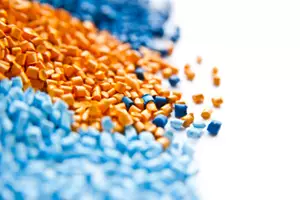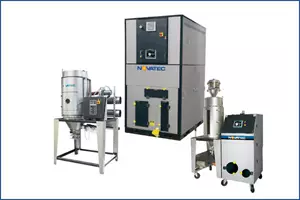Resin Drying Basics
Proper drying of plastic resin assures the best possible aesthetics and performance characteristics of a plastic product. Use this information as a guide to understanding the basics of drying plastic materials.
Drying plastic resin is utilized to minimize or eliminate problems that may be caused by too much or too little moisture in a plastic material during processing. Although most processors accept the need to pre-dry resins, particularly highly hygroscopic ones, many do not understand the basics – or even the vocabulary of resin drying.
The extent to which moisture affects the quality of a molded or extruded part is determined by the specific plastic resin being processed and the intended purpose of the part. Regardless, it is highly probable that improper or incomplete drying of the raw material will create problems, whether during processing or when the product is in use, or worse – both.

1. Heat
Heat is the driving force in drying. If you don’t heat the pellet it will not release its moisture. Hygroscopic polymers have a strong attraction for water and the water molecules are bound to the polymer chains. Heat causes the molecules to move about more vigorously, weakening the forces that bind the water molecules to the polymer chains. Above certain temperatures, the force that binds the water molecules to the polymer chains are reduced permitting free movement of the molecules to aid the drying process. Non-hygroscopic resins do not adsorb moisture internally into the pellet, however, moisture can collect on the surface of the pellet. Applying heat becomes an important part of removing surface moisture when this happens.

2. Dew Point
Dew Point is the temperature at which moisture in the air begins to condense. The low vapor pressure (dew point) of the dry air surrounding the pellet causes the freed moisture molecules to migrate to the surface of the pellet.

3. Drying Time
Plastic pellets do not dry instantaneously. They must first be heated to allow the water molecules free movement. Then, there must be sufficient time for the water molecules to diffuse to the surface of hygroscopic pellets or for surface moisture to evaporate from the surface of non-hygroscopic materials.

4. Airflow
Airflow carries heat or dry heated air to the material in the drying hopper. In the case of non-hygroscopic materials, you must force hot air over and around the pellets to remove surface moisture. With hygroscopic materials, you must force low dew point heated air over the material to make the molecules of moisture disengage from the polymer chains and move to the surface of the pellets where the airflow carries moisture away. The volume of dry air must be sufficient to develop and maintain the desired temperature profile within the drying hopper. If four hours drying time is required, you must maintain the drying temperature for the four-hour level within the drying hopper. If the volume of airflow is reduced, the temperature profile will be reduced.
Maximizing Energy Efficiency in Resin Drying Systems
Some dryer manufacturers tout energy savings while others, who don’t necessarily have testing facilities nor qualified personnel to conduct testing, try to convince processors that energy savings in a dryer is not worth talking about.
A look at energy costs of old vs. new dryers will quickly convince you otherwise. The trend of average electricity cost is UP so planning ahead to reduce your energy expenditures is a sensible thing to do. The larger the dryer – the greater the savings and the better the ROI.
The performance of any drying system is based on using the minimum heat to raise the temperature to the appropriate drying temperature while maintaining a constant material temperature at the throat of the injection molding machine or extruder. Also the regeneration system should minimize the energy used to heat the desiccant material while dedicating most of the energy to removing the moisture gained during the drying process.
Reducing Process Heat Loss
You must be cautious about how dryer manufacturers claim energy savings. Temperature Setback or Second Set Point are sometimes sold as energy-saving features but they are not. Most rely on “Temperature Setback” – what does that mean?
Temperature Setback lowers the process temperature in the dryer and thus the resin temperature entering the processing equipment. The result is the processing machine must make up for the lower heat in the resin by increasing the heat from shear and the band heaters. The processing machine ends up using more energy to overcome the shortcomings of the dryer, resulting in no energy savings, and contributing to an inferior end product or product consistency.
Reducing process heat loss to increase energy savings can also be accomplished through the use of VFD’s (variable frequency drives) to control process blower speed. If the airflow rate and temperature rise are minimized, the process heating energy can be as low as necessary to heat the resin. The idea is to minimize the air required so that the minimum energy is used for process heating. The temperature of the resin is still raised to the appropriate temperature for the process machine but all of the energy remains in the drying hopper and a minimal amount of heat or energy is returned to the dryer.
To accomplish this effectively the temperature of the resin and the temperature leaving the drying hopper should be continually measured and the air flow rate adjusted so the return air temperature (the temperature returning to the dryer from the drying hopper) is only slightly higher than the temperature of the resin entering the drying hopper. This process is controlled by varying the speed of the blower with a Variable Frequency Drive (VFD) which changes the speed of the blower and thus the flow rate of the air. By minimizing the air flow rate, while maintaining the temperature of the resin, the process heat is maintained at the lowest possible level. This allows the required power to adapt to any changes in material rate, resin moisture and temperature of the resin.
Electricity costs are trending up, so planning ahead to reduce your energy expenditures is a sensible thing to do. The larger the dryer, the greater the savings and the better the ROI.
Reducing Heat Loss in Desiccant Regeneration
Regeneration can account for as much as 35% of the total power used. To maximize energy savings, the power used in the regeneration of the desiccant must be minimal. Regeneration consists of heating the desiccant to a temperature at which it releases the moisture gained during the resin drying process. This involves raising the temperature of the desiccant to a point where the moisture retained in the desiccant dissipates.
There are two parts to this system – each with a specific task. We will demonstrate this using the desiccant wheel dryer as our model:
First, the speed (RPM) of the desiccant wheel is minimized which reduces the pounds per minute of desiccant media to be heated. This is important because heating of the desiccant media detracts from the primary goal of vaporizing moisture and heat is lost without accomplishing the primary goal of water removal. The wheel speed is controlled by a variable frequency drive (VFD) to no more than that required to adsorb the moisture from the return air. By controlling the speed of the wheel, the desiccant media is loaded to its maximum while maintaining a consistent dew point of less than – 40°F/C.
The second part is accomplished using a VFD on the regeneration air blower. The VFD minimizes the airflow to a point where water is desorbed from the molecular sieve but only minimal heat leaves the wheel during the regeneration process. As the ambient air is heated and passes through the wheel, the discharge temperature is constantly monitored and the VFD adjusts the air flow ensuring that minimal air flow is used to remove all of the moisture gained in drying but no excess air is used.
The temperature of the air exiting the top of the wheel is just enough to remove the moisture and carry it away but is kept at a constant temperature. This ensures that the wheel will remove all of the moisture from the resin regardless of the resin moisture level and will automatically adjust as the moisture changes due to seasonal variations or changes in the virgin/flake ratios.
Regeneration can account for as much as 35% of the total power used.
Consistency of Dried Materials
Proper, uniform drying assists in the molding or extrusion process and aids in the prevention of defects.
Molding times and extrusion rates can be optimized and increased by:
- Uniform Drying to a consistent, low moisture level.
- Maintaining a constant drying temperature.
- Keeping your drying system in good working condition.
- Utilize dryers offering the latest, proven drying technology to avoid temperature or dew point spikes and other inconsistencies.
Ask the Expert

Submit A Question

Glossary: Plastics Performance Issues
A glossary of descriptive terms to help identify the multitude of issues that may affect performance of plastics parts

Cost of Modern Dryers vs. Old Drying
In most cases, older dryers are energy hogs compared to dryers utilizing newer and more modern technology. How much is your dryer costing you.

Resin Types
A guide to the processing characteristics of popular resin types and the method and time required for drying of each.

Resin Dryer Technologies
There are at least a dozen types of drying technologies available to plastics processors. See which one is right for you.
